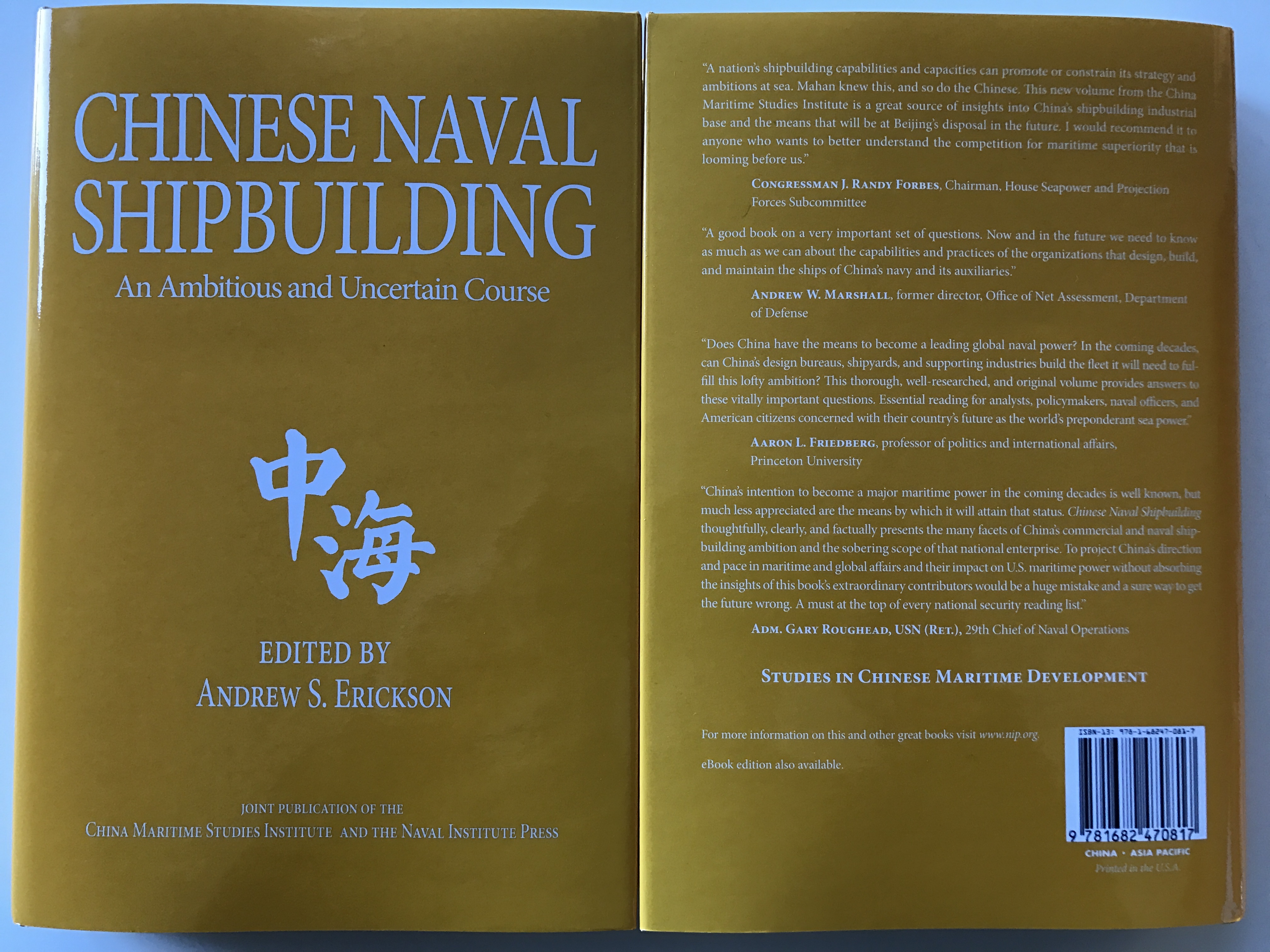Chinese Naval Shipbuilding Reviewed by Michael DeBoer at Center for International Maritime Security (CIMSEC)
Michael DeBoer; review of Andrew S. Erickson, ed., Chinese Naval Shipbuilding: An Ambitious and Uncertain Course (Annapolis, MD: Naval Institute Press, 2016); Center for International Maritime Security (CIMSEC), 9 January 2017.
Chinese Naval Shipbuilding Capability: An Uncertain Course adds the most recent volume to Dr. Andrew Erickson’s excellent edited collections on the increase of the People’s Republic’s military, economic, and industrial power published by the Naval Institute Press. Erickson’s credentials include a professorship in strategy at the Naval War College, a research associateship at Harvard’s Fairbank Center for Chinese Studies, and [serving as] a regular congressional witness on areas pertaining to Chinese capabilities and strategy. He is a giant in the field. The work combines seventeen articles written by thirty-two authors, among them storied names such as CRS naval analyst Ronald O’Rourke and former former Director of Intelligence and Information Operations (N2) for U.S. Pacific Fleet CAPT James Fanell (ret). The volume provides a nuanced and insightful view of a major Chinese strategic investment, its shipbuilding industry, and is required reading for anyone, academic or layman, trying to understand the associated capabilities and implications of the People’s Republic’s maritime rise.
The three hundred-forty-page tome is broken into five sections, describing the PRC’s shipbuilding industry’s foundation and resources, infrastructure, approach to naval architecture and design, remaining challenges, and a section which provides strategic conclusions and predictions for the future of American naval and maritime power. The articles are easily readable, each approximately ten to fifteen pages of crisp, synthesized content, with end notes allowing readers to further explore the author’s research, although most references are translated from Mandarin Chinese. The works also feature multiple graphs, tables, and illustrations, providing further resources for students and researchers. While each article provides fascinating insights into the past, present, and future of Chinese shipbuilding, four areas of study especially stood out as enjoyable, informative, and useful.
First, Christopher P. Carlson and Jack Bianchi’s Chapter I review of the People’s Republic’s naval and maritime history from the formation of the communist state to Xi Jinping provides a concise review of the People’s Liberation Army Navy’s (PLAN) strategic development. Carlson and Bianchi first review the PLAN’s operational shift from Near Coast Defense, to Near Seas Active Defense, and finally to Near Seas Defense and Far Seas Operations, as the PLAN’s resources, capabilities, and objectives adapted to match the nation’s goals. The pair provide an excellent linkage between China’s strategic situation since Mao’s victory and the requirements of PLAN platforms as the force shifted from a coastal force to a limited blue water force and finally to a force intended to defend Chinese interests on both the near and far seas. This evolution brought an increase in the complexity and technical sophistication to the Chinese military shipbuilding industry.
Second, Leigh Ann Ragland-Luce and John Costello provide insight into a major limitation of Chinese military shipbuilding: combat electronics. Ragland-Luce and Costello point out that, while PLAN hull and mechanical systems are regularly manufactured using modern industry standards such as modular construction, the PLAN remains unable to field a top-tier indigenously developed combat control system. The authors use the Jiangkai-II (054A)-class guided missile frigate, a modern warship by any standard, whose combat control system (CCS) is based upon the French TAVITAC, vice a comparable Chinese design. This potential lack of integration between the French CCS and developing Chinese weapons and sensor systems might well prove a combat handicap for PLAN forces in future conflicts. Similarly, editor Andrew Erickson with Jonathan Ray and Robert T. Forte provide an excellent dissertation on the limitations of Chinese propulsion plant designs. According to the trio, the PLAN appears proficient in coastal diesel submarine propulsion technologies. The PLAN effectively integrates Sterling Engine Air Independent Propulsion (AIP) systems into its Yuan-class diesel-electric boats (SSPs), and it leads research into safe Lithium-Ion battery storage systems, potentially increasing coastal submarine endurance. It still lags considerably in both modern integrated surface propulsion plants and nuclear powered propulsion designs.
Third, the work uses present shipbuilding capacity to extrapolate future PLAN capability and force structure. CAPT James Fanell (ret) and Scott Cheney-Peters (Founder of CIMSEC) provide a realistic warning regarding the long-term challenge of Chinese strategic depth in military shipbuilding. Ronald O’Rourke caps the work with a set of implications for the U.S. Navy if PLAN force structure continues to expand.
Fourth, the work also provides an excellent overview of the curious public-private nature of an industry. The ten-year old split of Chinese shipbuilding into competitive public-private corporations Chinese State Shipbuilding Company (CSSC) and Chinese Industrial Shipbuilding Company (CSIC), induced formidable challenges to reintegrate as demand for commercial Chinese-built shipping demand drops and the People’s Republic attempts to cut excess overhead in its public ventures. The work also appropriately conveys the confusing and byzantine structure of the Chinese military-industrial complex, broken into multiple institutes and directorates with potentially overlapping responsibilities. …
Overall, Chinese Naval Shipbuilding provides a very useful window into an area of intense Communist Party strategic investment. The work gives the reader an excellent overview of the industry as a whole, overlapped with strategic context and geopolitical implications. As discussed, the volume also provides a unique look at the industry’s challenges, including increased engineering costs, poor integration with modern combat systems, and challenges in surface ship engineering plants and nuclear propulsion technologies. Nuanced and complex, it describes both the accomplishments of an industry that now leads the world in commercial tonnage produced, but also lags behind in critical areas mastered by much smaller and less-rich nations. Erickson’s volume is a worthy addition to his series and an enjoyable read.
Read CIMSEC’s interview with editor Dr. Andrew Erickson on this book here.
COMPLETE INFORMATION ON VOLUME:
Andrew S. Erickson, ed., Chinese Naval Shipbuilding: An Ambitious and Uncertain Course (Annapolis, MD: Naval Institute Press, 2016).
Eventually, as with the previous five volumes in our “Studies in Chinese Maritime Development” series, there will be an Amazon Kindle edition; and an authorized Chinese-language translation through Ocean Press, China’s leading maritime publisher!
Author, “China’s Military Shipbuilding Industry Steams Ahead, On What Course?” 1-16.
Coauthor, “Underpowered: Chinese Conventional and Nuclear Naval Power and Propulsion,” 238-48.
ISBN-10: 1682470814
ISBN-13: 978-1682470817
Hardcover: 376 pages
Series: Studies in Chinese Maritime Development
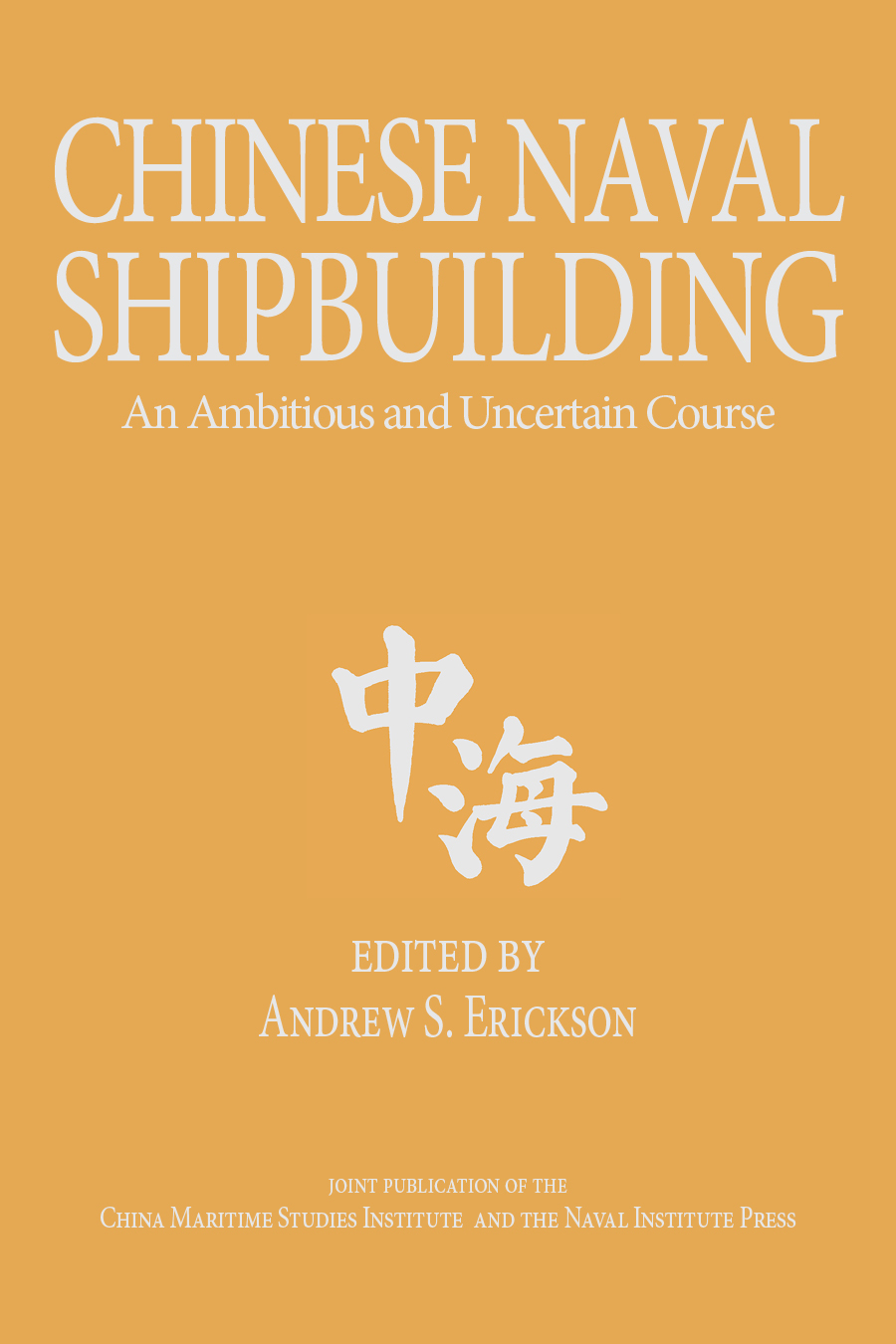
Andrew S. Erickson, ed., Chinese Naval Shipbuilding: An Ambitious and Uncertain Course (Annapolis, MD: Naval Institute Press, 2016).
BOOK DESCRIPTION
One of this century’s most significant events, China’s maritime transformation is already making waves. Yet China’s course and its implications, including at sea, remain highly uncertain―triggering intense speculation and concern from many quarters and in many directions. It has never been more important to assess what ships China can supply its navy and other maritime forces with, today and in the future. China’s shipbuilding industry has grown more rapidly than any other in modern history. Commercial shipbuilding output jumped thirteen-fold from 2002-12. Beijing has largely met its goal of becoming the world’s largest shipbuilder by 2015. Yet progress is uneven, with military shipbuilding leading overall but with significant weakness in propulsion and electronics for military and civilian applications alike. Moreover, no other book has answered three pressing questions: What are China’s prospects for success in key areas of naval shipbuilding? What are the likely results for China’s navy? What are the implications for the U.S. Navy?
To address these critical, complex issues, this volume brings together some of the world’s leading experts and linguistic analysts, often pairing them in research teams. These sailors, scholars, analysts, industry experts, and other professionals have commanded ships at sea, led shipbuilding programs ashore, toured Chinese vessels and production facilities, invested in Chinese shipyards and advised others in their investment, and analyzed and presented important data to top-level decision-makers in times of crisis. In synthesizing their collective insights, the book fills a key gap in our understanding of China, its shipbuilding, its navy, and what it all means.
Their findings will fascinate and concern you. While offering different perspectives, they largely agree on several important points. Through a process of “imitative innovation,” China has been able to “leap frog” some naval development, engineering, and production steps and achieve tremendous cost and time savings by leveraging work done by the U.S. and other countries. China’s shipbuilding industry is poised to make the People’s Liberation Army Navy (PLAN) the second largest navy in the world by 2020, and―if current trends continue―a combat fleet that in overall order of battle (i.e., hardware-specific terms) is quantitatively and even perhaps qualitatively on a par with that of the U.S. Navy by 2030. Already, Chinese ship-design and -building advances are increasing the PLAN’s ability to contest sea control in a widening arc of the Western Pacific.
China continues to lack transparency in important respects, but much is knowable through the interdisciplinary research approach pioneered by the Naval War College’s China Maritime Studies Institute in the series “Studies in Chinese Maritime Development,” of which this is the sixth volume.

BLURBS
“A nation’s shipbuilding capabilities and capacities can promote or constrain its strategy and ambitions at sea. Mahan knew this, and so do the Chinese. This new volume from CMSI is a great source of insights on China’s shipbuilding industrial base and the means that will be at Beijing’s disposal in the future. I would recommend it to anyone who wants to better understand the competition for maritime superiority that is looming before us.”
—Congressman J. Randy Forbes, Chairman, House Seapower and Projection Forces Subcommittee
“A good book on a very important set of questions. Now and in the future we need to know as much as we can about the capabilities and practices of the organizations that design, build, and maintain the ships of China’s navy and its auxiliaries.”
—Andrew W. Marshall, former Director, Office of Net Assessment, Pentagon
“Does China have the means to become a leading global naval power? In the coming decades, can China’s design bureaus, shipyards, and supporting industries build the fleet it will need to fulfill this lofty ambition? This thorough, well-researched, and original volume provides answers to these vitally important questions. Essential reading for analysts, policymakers, naval officers, and American citizens concerned with their country’s future as the world’s preponderant sea power.”
—Aaron L. Friedberg, Professor of Politics and International Affairs, Princeton University
“To understand China’s naval future, we must understand what its shipbuilding industry can provide. This path-breaking volume points the way.”
—Evan S. Medeiros, former Senior Director for Asian Affairs, U.S. National Security Council
“China’s intention to become a major maritime power in the coming decades is well known, but much less appreciated are the means by which it will attain that status. Andrew Erickson’s Chinese Naval Shipbuilding: An Ambitious and Uncertain Course thoughtfully, clearly, and factually presents the many facets of China’s commercial and naval shipbuilding ambition and the sobering scope of that national enterprise. To project China’s direction and pace in maritime and global affairs and their impact on U.S. maritime power without absorbing the insights of this book’s extraordinary contributors would be a huge mistake and a sure way to get the future wrong. A must at the top of every national security reading list.”
—Admiral Gary Roughead, USN (Ret.), 29th Chief of Naval Operations
“The contributors to this volume shed new light on an important but under-studied topic: the industrial sinews of China’s naval modernization and expansion. It deserves to be studied by scholars and policy makers alike.”
—Thomas G. Mahnken, President and CEO, Center for Strategic and Budgetary Assessments
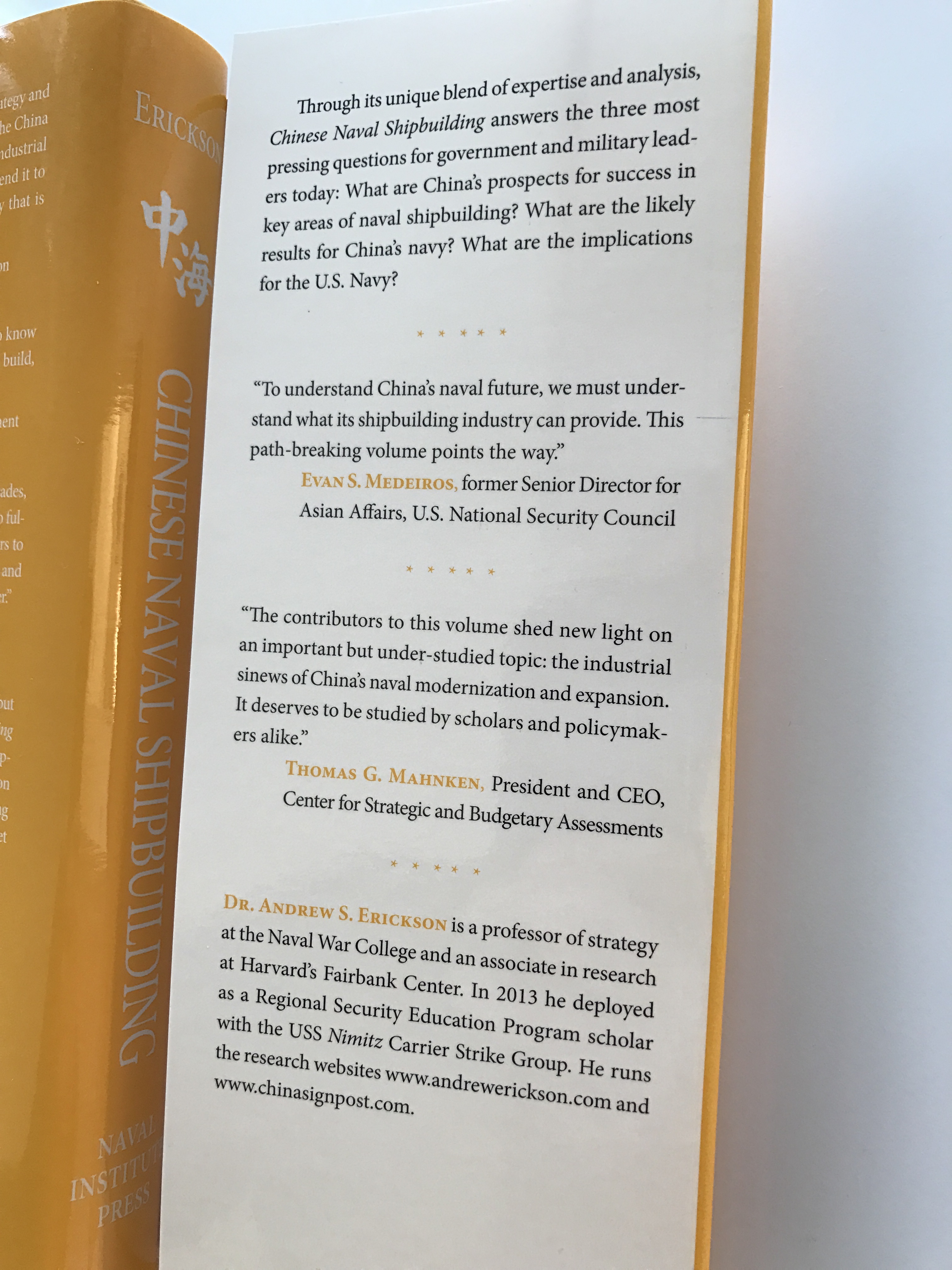
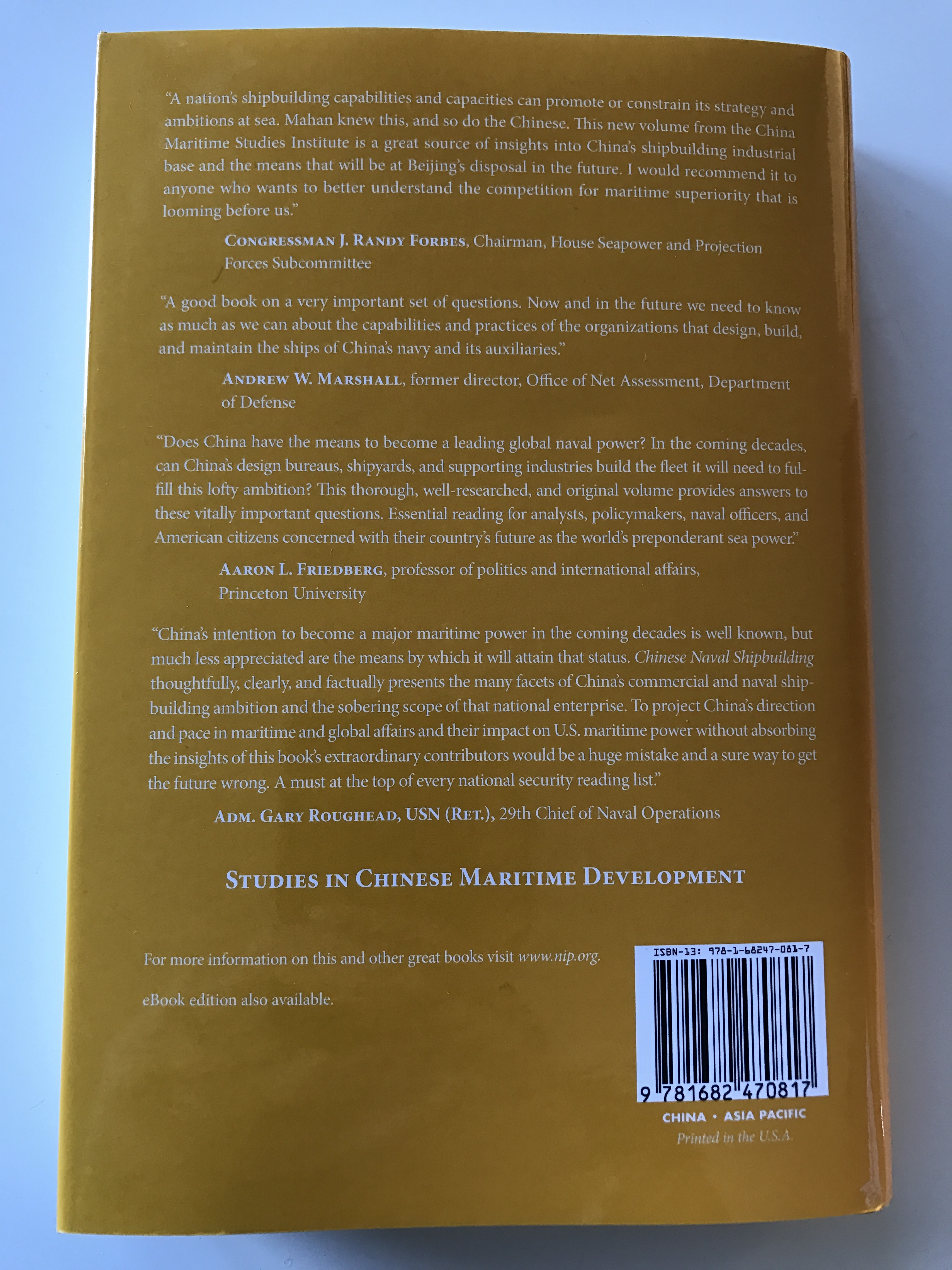
CONTENTS OF VOLUME
List of Exhibits
Acknowledgments
Introduction. China’s Military Shipbuilding Industry Steams Ahead, On What Course?
Andrew S. Erickson
Part I. FOUNDATION AND RESOURCES
Warfare Drivers: Mission Needs and the Impact on Ship Design
Christopher P. Carlson and Jack Bianchi
Status, Goals, Prospects: Party-State Strategic Requirements for China’s Shipbuilding Industry
Morgan Clemens and Ian Easton
Resources for China’s State Shipbuilders: Now Including Global Capital Markets
Gabe Collins and Eric Anderson
Part II. SHIPYARD INFRASTRUCTURE
Key Factors in Chinese Shipyards’ Development and Performance: Commercial-Military Synergy and Divergence
Sue Hall and Audrye Wong
China’s Naval Strength: Current and Future
Alex Pape and Tate Nurkin
Monitoring Chinese Shipbuilding Facilities with Satellite Imagery
Sean O’Connor and Jordan Wilson
Civil-Military Integration Potential in Chinese Shipbuilding
Daniel Alderman and Rush Doshi
Part III. NAVAL ARCHITECTURE AND DESIGN
PLAN Warship Construction and Standardization
Mark Metcalf
China’s Military Shipbuilding Research, Development, and Acquisition System
Kevin Pollpeter and Mark Stokes
China’s Civilian Shipbuilding in Competitive Context: An Asian Industrial Perspective
Julian Snelder
Part IV. REMAINING SHIPBUILDING CHALLENGES
PLA Shipboard Electronics: Impeding China’s Naval Modernization
Leigh Ann Ragland-Luce and John Costello
Underpowered: Chinese Conventional and Nuclear Naval Power and Propulsion
Andrew S. Erickson, Jonathan Ray, and Robert T. Forte
China’s Aircraft Carrier Program: Drivers, Developments, Implications
Andrew Scobell, Michael E. McMahon, Cortez A. Cooper III, and Arthur Chan
Part V. CONCLUSIONS AND ALTERNATIVE FUTURES
Maximal Scenario: Expansive Naval Trajectory to “China’s Naval Dream”
James E. Fanell and Scott Cheney-Peters
Medium Scenario: World’s Second “Far Seas” Navy by 2020
Michael McDevitt
Technological “Wild Cards” and Twenty-First-Century Naval Warfare
Paul Scharre and Tyler Jost
How China’s Shipbuilding Output Might Affect Requirements for U.S. Navy Capabilities
Ronald O’Rourke
List of Acronyms
About the Contributors
Index
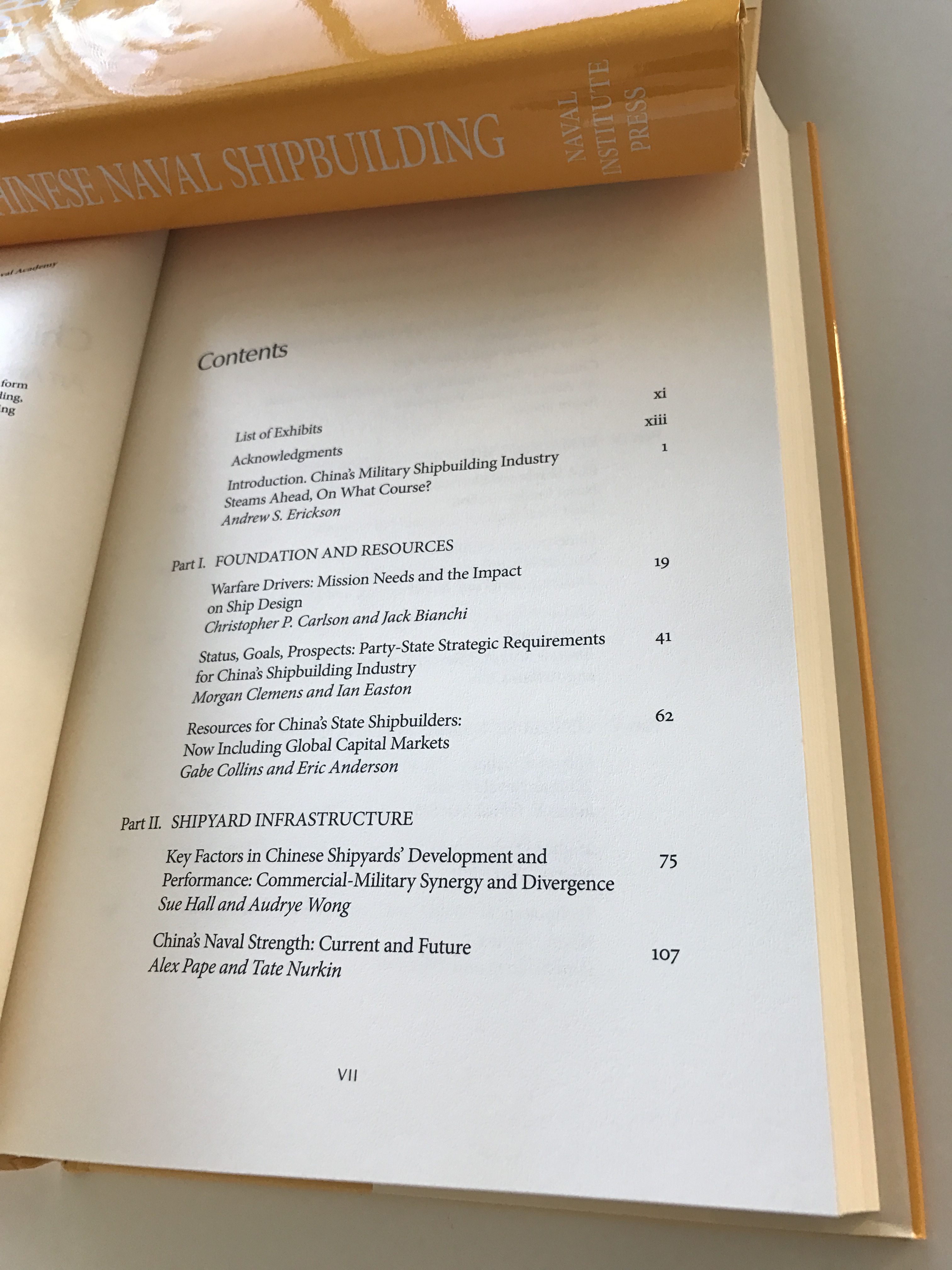
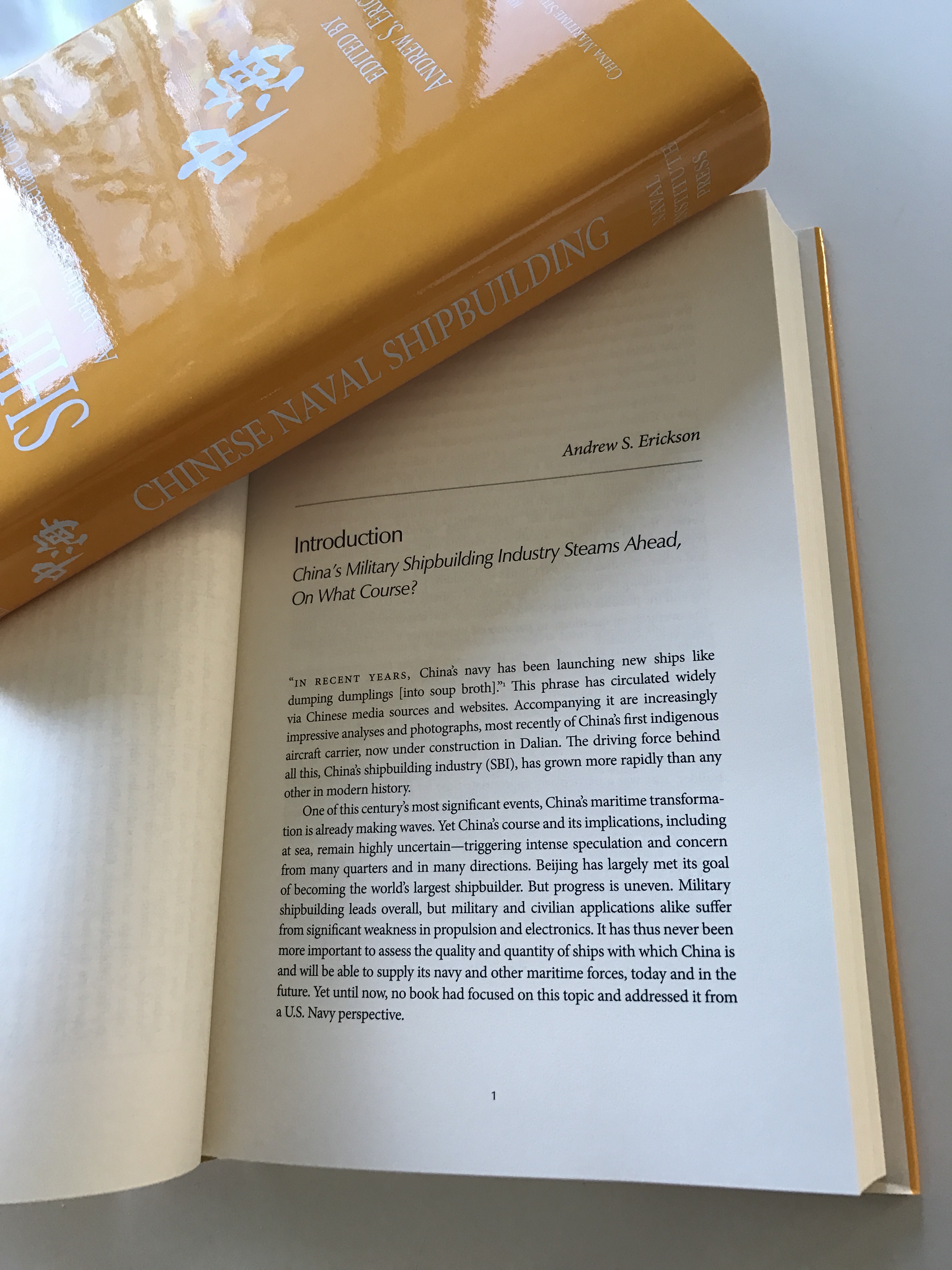
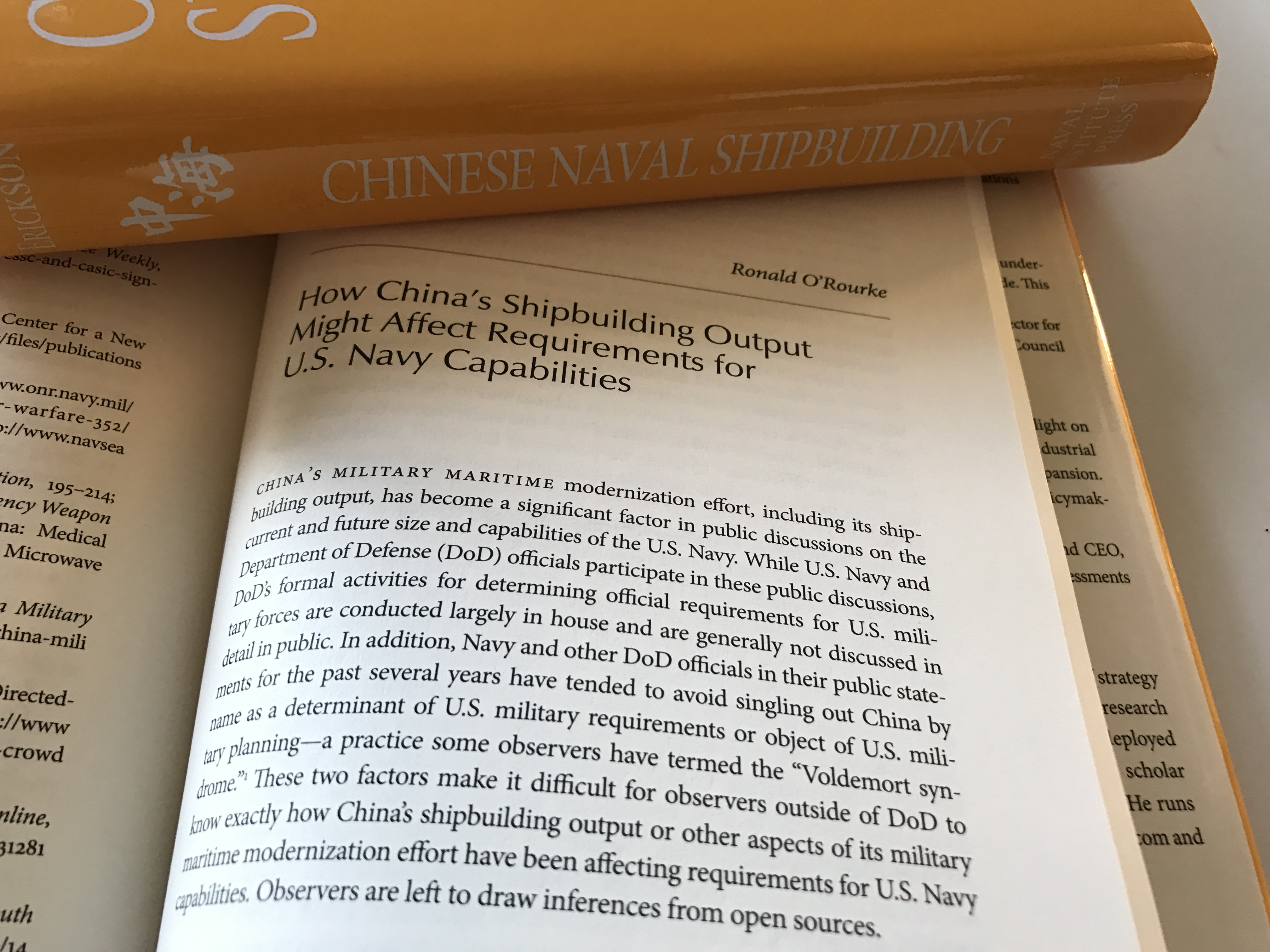
ABOUT THE CONTRIBUTORS
Daniel Alderman, a deputy director at Defense Group, Inc. (DGI), is Chinese language–proficient and oversees analytic production at DGI’s Center for Intelligence Research and Analysis.
Eric Anderson, a Chinese-proficient research analyst, leads Sino-American sectoral innovation analysis at the University of California (UC), San Diego’s Study of Innovation and Technology in China (SITC) project.
Jack Bianchi, a research associate at DGI, employs Chinese-language sources to analyze China’s defense-related science and technology development.
Capt. Christopher P. Carlson, USNR (Ret.), a submariner and intelligence officer, designs war games and has published a wide range of articles and books.
Arthur Chan, a research associate at RAND, is proficient in Chinese.
Scott Cheney-Peters, a civil servant at the State Department and a Reserve surface warfare officer, is founder and president of the Center for International Maritime Security.
Morgan Clemens, a research analyst at DGI, studies China’s armed forces and defense industry using Chinese-language sources.
Gabe Collins, a licensed Texas attorney, conducts security, commodity, and market research in Chinese, Russian, and Spanish.
Lt. Col. Cortez A. Cooper III, USA (Ret.), is a Chinese language– proficient senior policy analyst at RAND and affiliate faculty member of Pardee RAND Graduate School.
John Costello, a Chinese language–proficient U.S. Navy veteran with intelligence analysis and program management experience, is a research analyst at DGI.
Rush Doshi, a Raymond Vernon fellow in Harvard University’s Ph.D. program in government, conducts research in Mandarin and Hindi.
Ian Easton, a research fellow at the Project 2049 Institute, uses Chinese-language sources to analyze emerging Asian security issues.
Capt. James E. Fanell, USN (Ret.), a naval intelligence officer specializing in Indo-Asia-Pacific security affairs for nearly three decades, runs the leading English-language listserv on Chinese military issues.
Lt. Col. Robert T. Forte, USMC (Ret.), formerly U.S. naval attaché at U.S. Embassy Beijing, is a senior research analyst with DGI.
Sue Hall is managing director of Shipyard Economics, a firm providing specialist consulting services in the shipbuilding, ship repair, and shipyard industries worldwide.
Tyler Jost, a Chinese language–proficient former Army intelligence officer, is a Ph.D. student in Harvard University’s Government program.
Rear Adm. Michael McDevitt, USN (Ret.), an analyst of China’s maritime developments, formerly carrier battle group commander and commandant of the National War College, is presently a senior fellow at the CNA Corporation.
Rear Adm. Michael E. McMahon, USN (Ret.), a senior research associate at RAND with a Ph.D. in mechanical engineering, served as the U.S. Navy’s fifth program executive officer for aircraft carriers.
Cdr. Mark Metcalf, USN (Ret.), a surface warfare officer and naval cryptologist, provides systems engineering and Chinese-language research, translation, and technical analysis support to government clients.
Tate Nurkin is senior director of the Strategic Assessments and Futures Studies Center for IHS Aerospace, Defense, and Security.
Sean O’Connor is the principal imagery analyst at IHS Jane’s.
Ronald O’Rourke, a naval analyst for the Congressional Research Service of the Library of Congress, issues constantly updated reports on China’s navy.
Alex Pape is a principal analyst with IHS Jane’s DS Forecast and Defence Procurement, which provide real-time coverage of procurement and upgrade programs worldwide.
Kevin Pollpeter, a Chinese language–proficient senior research scientist at CNA, has also served as deputy director of technically focused research programs at both UC San Diego and DGI.
Leigh Ann Ragland-Luce, a research analyst at DGI, conducts Chinese-language research on China’s defense electronics and information technology sectors.
Jonathan Ray, a DGI research associate, conducts Chinese-language studies of national security, science, and technology issues.
Paul Scharre, a former infantryman in the Army’s 75th Ranger Regiment with multiple tours in Iraq and Afghanistan, is a senior fellow and director of the 20YY Future of Warfare Initiative at the Center for a New American Security.
Andrew Scobell, proficient in Chinese, is a senior political scientist at RAND and adjunct professor of Asian studies at Georgetown’s School of Foreign Service.
Julian Snelder, a partner in a global investments fund, has conducted investment research from Asia for nearly a quarter-century.
Lt. Col. Mark Stokes, USAF (Ret.), the Chinese-proficient executive director of the Project 2049 Institute, formerly served as assistant air attaché at U.S. Embassy Beijing.
Audrye Wong, fluent in Chinese, is a Ph.D. student in Security Studies at Princeton’s Woodrow Wilson School of Public and International Affairs.
Jordan Wilson is a policy analyst at the U.S.-China Economic and Security Review Commission, where he conducts Chinese-language research.
ABOUT THE EDITOR
Andrew S. Erickson, a U.S. Naval War College Professor of Strategy and Associate in Research at Harvard University’s Fairbank Center for Chinese Studies who is proficient in Chinese, blogs at www.andrewerickson.com.

LIST OF EXHIBITS
Exhibit 0-1. Significant Chinese Naval Shipyards
Exhibit 0-2. China’s Primary Order of Battle (Major Combatants), 1985–2030
Exhibit 1-1. Evolution of China’s Naval Strategy—Impact on PLAN Warfare Area Capabilities
Exhibit 4-1. Shipbuilding Production Trends Since 1990 (in millions of compensated gross tons)
Exhibit 4-2. Historical Shipbuilding Production (in millions of gross tons)
Exhibit 4-3. Trends in Production, Ordering, and Forward Orderbook for World Shipbuilding (in millions of compensated gross tons)
Exhibit 4-4. World Historical Production and Orderbook Phasing (in millions of compensated gross tons)
Exhibit 4-5. China Historical Production and Orderbook Phasing
Exhibit 4-6. Top 20 Chinese Shipbuilders from China’s Shipyards Report 2003
Exhibit 4-7. Top 20 Chinese Shipbuilders, 2012
Exhibit 4-8. Shipbuilding Throughput Comparison of Major Shipbuilders
Exhibit 4-9. Shipbuilding Throughput Changes for Chinese Shipbuilders
Exhibit 4-10. New Ship Price Volatility
Exhibit 4-11. Complexity Ranking of Ships According to Average Compensated Gross Ton (CGT) Coefficient
Exhibit 4-12. Composition of Chinese Shipbuilding Production by Size and Complexity
Exhibit 5-1. Estimated Chinese Investment in Naval Ship Construction by Type, 2010–24
Exhibit 5-2. Bohai (Huludao) Shipyard Military Output, 2006–30
Exhibit 5-3. Wuchang (Wuhan) Shipyard Military Output, 2006–30
Exhibit 5-4. Jiangnan (Shanghai) Shipyard Military Output, 2006–30
Exhibit 5-5. Hudong (Shanghai) Shipyard Military Output, 2006–30
Exhibit 5-6. Huangpu Shipyard Military Output, 2006–30
Exhibit 6-1. Configuration and Growth of China’s Huludao Shipyard
Exhibit 7-1. China’s White-Listed Shipyards
Exhibit 8-1. Types of GJBs (Guojia Junyong Biaozhun, PRC National Military Standards)
Exhibit 8-2. Electromagnetic Compatibility—GJBs and MIL-STDs
Exhibit 8-3. GJB 4000-2000 Subject Areas
Exhibit 9-1. China’s IDAR Technology Innovation Process
Exhibit 9-2. First Five Stages in Military Shipbuilding Research and Development Process
Exhibit 9-3. Primary Organizations Involved in China’s Military Shipbuilding
Exhibit 10-1. Experts’ Assessment of China Capability Gap versus Class Leader
Exhibit 11-1. Key Shipbuilding Organizations Specializing in Shipboard Electronics
Exhibit 14-1. PLAN—Platform Inventory in 2015
Exhibit 14-2. PLAN 2030—Forecast Platform Inventory
Exhibit 15-1. Far Seas Navies’ Major Ships, circa 2020
Exhibit 15-2. Major Far Seas Ships, PLAN vs. U.S. Navy, circa 2020
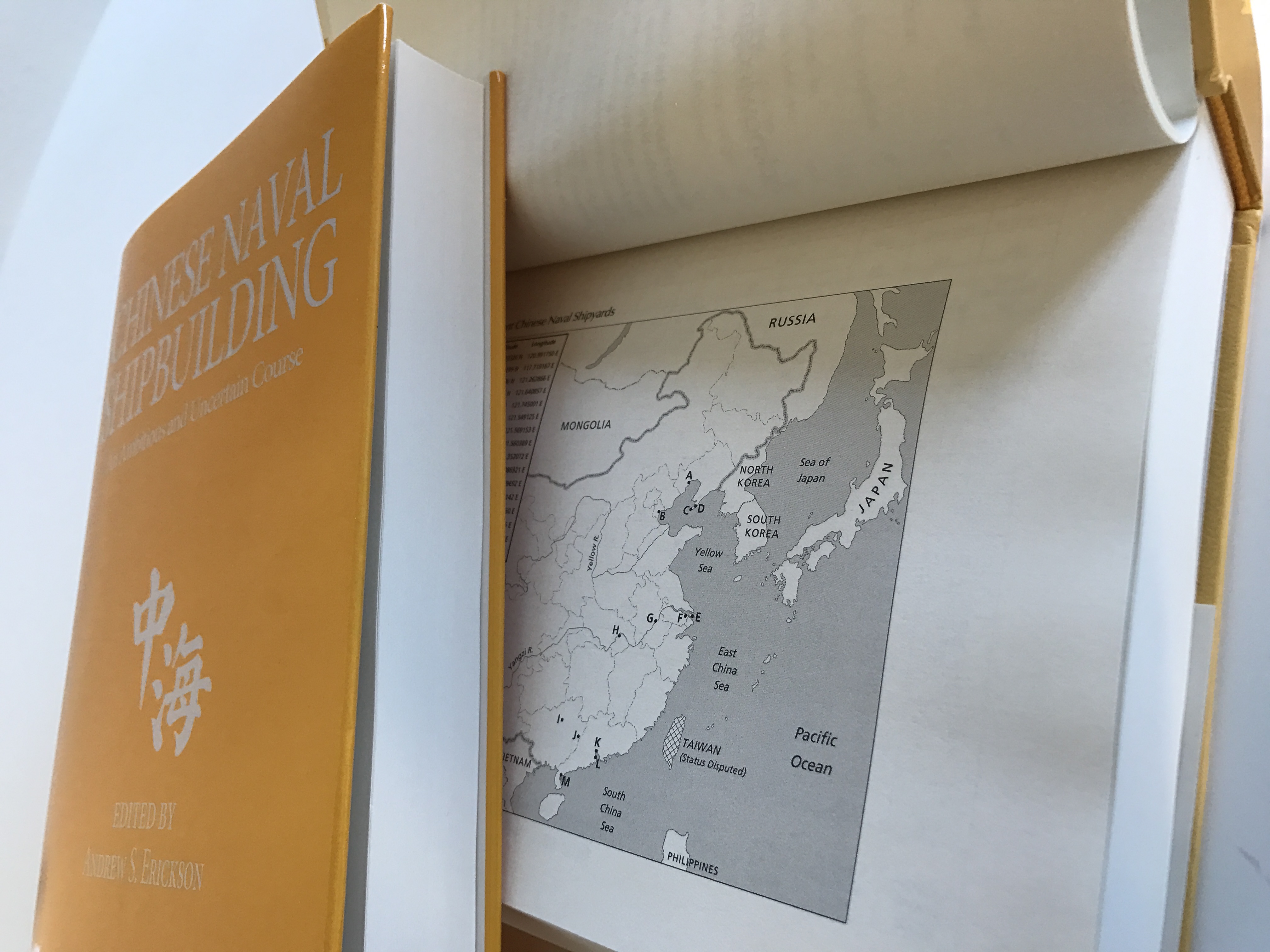
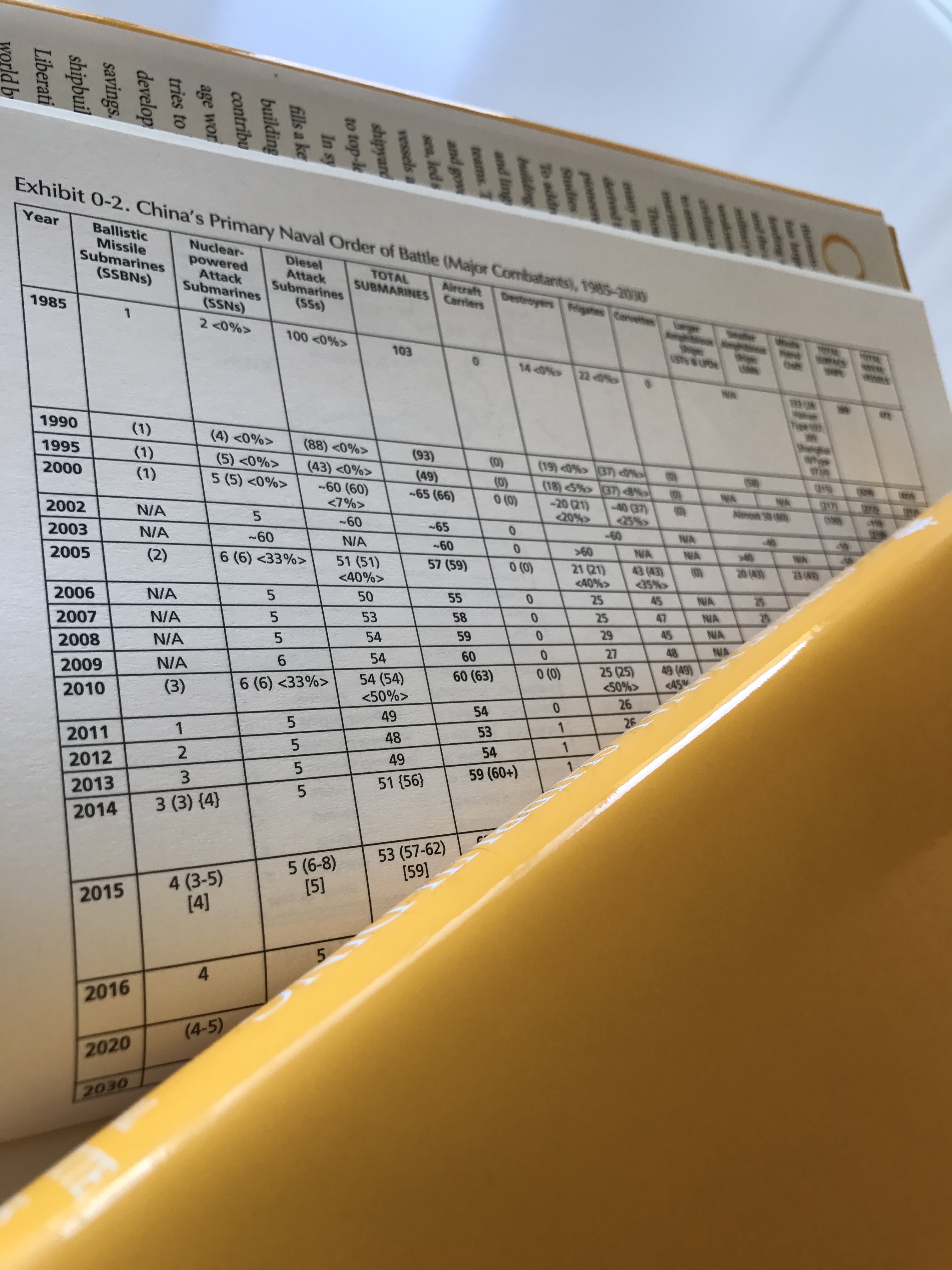

ACKNOWLEDGMENTS
On behalf of the China Maritime Studies Institute (CMSI), the editor thanks the Naval War College (NWC) Foundation for its important contributions in support of CMSI’s 2015 annual conference and this resulting volume. The foundation’s generosity has long played a crucial role in ensuring that such events and the publications that flow from them are of the highest caliber, and this past year has offered a particularly important example of that invaluable partnership.
As with all CMSI events and conference volumes, countless individuals have made vital contributions. While it is not possible to list them individually, the editor extends his sincere gratitude to all concerned. The support of the leadership of NWC, and of the U.S. Navy more broadly, has been crucial to our efforts. Finally, the Naval Institute Press is to be commended for its professionalism and dedication to the Studies in Chinese Maritime Development series in which this sixth volume appears. That series is the product of nearly a decade of constructive collaboration between two vital historic centers of American thinking on sea power: Annapolis and Newport.
Andrew Sven Erickson
Newport, Rhode Island
December 2015
INTRODUCTION TO “STUDIES IN CHINESE MARITIME DEVELOPMENT” SERIES
Andrew S. Erickson, editor
Powered by the world’s second largest economy and defense budget, China is going to sea with a scale and sophistication that no continental power ever before sustained in the modern era. Its three sea forces are all leaders in their own right: the world’s second-largest blue water navy, the world’s largest blue water coast guard, and the world’s largest (and virtually only) maritime militia.
While paramount leader Xi Jinping is working to transform his nation further into a “great maritime power,” at a minimum today’s Middle Kingdom is already a hybrid land-sea power. Amid European decline and American fiscal and strategic challenges, this historic transformation has the potential to end six centuries of largely Western dominance of the world’s oceans. To properly inform its strategy and policy, the U.S. Navy and nation must understand this momentous sea change.
Since its establishment in 2006 the China Maritime Studies Institute has been conducting research and holding conferences covering the broad waterfront of Chinese oceanic efforts in order to advise U.S. Navy leadership and support the Naval War College in its core mission area of helping to define the future Navy. The Studies in Chinese Maritime Development series assembles the resulting proceedings into edited volumes focusing on specific topics of importance to further understand the dynamics of these changes.
Previous Titles in the Series
China’s Future Nuclear Submarine Force
China’s Energy Strategy: The Impact on Beijing’s Maritime Policies
China Goes to Sea: Maritime Transformation in Comparative Historical Perspective
China, the United States and 21st-Century Sea Power: Defining a Maritime Security Partnership
Chinese Aerospace Power: Evolving Maritime Roles
RELATED READING
EDITOR’S INTERVIEW REGARDING THIS VOLUME WITH THE PRESIDENT OF THE CENTER FOR INTERNATIONAL MARITIME SECURITY:
Sally DeBoer, “A Conversation with Dr. Andrew Erickson on Chinese Naval Shipbuilding,” Center for International Maritime Security (CIMSEC), 19 December 2016.
On the occasion of the publication of his newest book, Chinese Naval Shipbuilding: An Ambitious and Uncertain Course, the 6th volume in the USNI Press’ Studies in Chinese Maritime Development Series, CIMSEC spoke with editor and author Dr. Andrew Erickson, Professor of Strategy in, and a core founding member of, the U.S. Naval War College (NWC)’s China Maritime Studies Institute (CMSI).
SD: Dr. Erickson, thank you so much for joining CIMSEC to talk about your new book, Chinese Naval Shipbuilding. This topic is of great interest to our readership, and your book is perhaps the most comprehensive, detailed, and up-to-date look at the growth, and specifically the methods and implications of that growth, of the People’s Liberation Army – Navy (PLAN). To begin, can you tell us a bit about yourself and what brought you to this topic?
AE: In twelve years in Newport, I’ve been privileged to help establish the U.S. Navy (USN)’s China Maritime Studies Institute (CMSI) and turn it into a recognized research center that has inspired both the Air Force’s China Aerospace Studies Institute and the Naval War College’s Russia Maritime Studies Institute. In my own analysis, I’ve explored new areas of Chinese-language methodology and worked to develop new concepts and findings that can enhance U.S. understanding of, and policies toward, China.
With the support of CMSI’s current director, Professor Peter Dutton, I have recently applied our Institute’s resources to examining the industrial underpinnings of one of this century’s most significant events, China’s maritime transformation. Strong strategic demand signals and guidance from civilian authorities, combined with solid shipbuilding industry capability, are already driving rapid progress. Yet China’s course and its implications, including at sea, remain highly uncertain—triggering intense speculation and concern from many quarters and in many directions. Moreover, despite these important dynamics, no book had previously focused on this topic and addressed it from a USN perspective. Like the CMSI conference on which it is based, the resulting volume in our series with the Naval Institute Press, “Studies in Chinese Maritime Development,” focuses some of the world’s leading experts and analysts on addressing several crucial questions of paramount importance to the USN and senior decision makers: To what extent, and to what end, is China going to sea? What are China’s prospects for success in key areas of naval shipbuilding? What are the likely results for China’s navy? What are the implications for the USN?
SD: Part One of the text deals with Foundations and Resources, meaning the foundations of China’s shipbuilding industry and the assets supporting its efforts. The first chapter, in fact, explores how the evolution of China’s maritime strategy impacts future ship design. From your perspective, what primary mission needs will drive Chinese shipbuilding over the next quarter century, and what effect will that have on the fleet?
AE: China’s primary focus remains upholding its interests and promoting its disputed claims in the “Near Seas”—which encompass the waters within the First Island Chain (the Yellow Sea, East China Sea, and South China Sea)—as well as defending their immediate approaches. It also has a growing desire to increase operational capability in the “Far Seas”—beyond the First Island Chain. This is essentially about being able to project power. First, to improve the defense of China itself; and second, to defend China’s growing economic interests abroad, which largely depend on unfettered access to the sea.
However, operating at greater distances from China places greater demands on its naval platforms as it becomes far more difficult to support surface ships, submarines, and aircraft the farther they move away from the coast. If we look at the desired capabilities for Far Seas operations, then we should expect improvements in surface combatant area anti-air defenses, anti-submarine warfare, and strike warfare. Chinese deck aviation components are largely air defense assets right now. A robust land attack/strike capability is the next step. Improvements in acoustic quieting are absolutely necessary if PLAN submarines are to survive being targeted in deeper, blue water environments. Shifts toward anti-submarine and strike warfare will represent the biggest likely changes in combat capabilities. Also required: a significant improvement in Chinese logistics support to sustain deployed platforms. The PLAN has started actively pursuing these goals, but it will take some time before it masters them. …
EDITOR’S PERSONAL SUMMARY OF THE KEY FINDINGS FROM THE CONFERENCE ON WHICH THIS FURTHER-DEVELOPED AND JUST-UPDATED VOLUME IS BASED:
Andrew S. Erickson, “Steaming Ahead, Course Uncertain: China’s Military Shipbuilding Industry,” The National Interest, 19 May 2016.
“In recent years, China’s navy has been launching new ships like dumping dumplings [into soup broth].” This phrase has circulated widely via Chinese media sources and websites. Accompanying it are ever-more-impressive analyses and photographs, most recently of China’s first indigenous aircraft carrier, now under construction in Dalian. The driving force behind all this, China’s shipbuilding industry, has grown more rapidly than any other in modern history.
One of this century’s most significant events, China’s maritime transformation is already making waves. Still, however, China’s course and its implications—including at sea—remain highly uncertain, triggering intense speculation and concern from many quarters and in many directions. Beijing has largely met its goal of becoming the world’s largest shipbuilder. Yet progress remains uneven, with military shipbuilding leading overall but with significant weakness in propulsion and electronics for military and civilian applications alike. It has thus never been more important to assess what quality and quantity of ships is China able to supply its navy and other maritime forces with, today and in the future. Somewhat surprisingly, however, there has been insufficient attention to this topic, particularly from a U.S. Navy (USN) perspective.
To bridge that gap, a diverse group of some of the world’s leading sailors, scholars, analysts, industry experts, and other professionals convened at the Naval War College (NWC) on 19-20 May 2015 for a two-day conference on “China’s Naval Shipbuilding: Progress and Challenges.” Hosted by NWC’s China Maritime Studies Institute (CMSI), it was cosponsored with the U.S. Naval Institute (USNI), which will publish the resulting edited volume early next year.
CMSI was formally established on 1 October 2006. Its research and analysis of China’s maritime capabilities helps to inform USN leadership and supports NWC in its core mission area of helping to define the future Navy. The annual CMSI conference is a principal function of the Institute, supporting focused examination of the full range of Chinese maritime developments.
This conference, the tenth in a series, focused on a topic of great interest to USN leaders: China’s naval shipbuilding industry. “Shipbuilding” includes construction of new vessels, the repair and modification of existing ones, and the production and repair of shipboard and associated equipment. Paper presenters, discussants, and other attendees analyzed China’s shipbuilding capacity in order to deepen understanding of the relative trajectories of Chinese and American naval shipbuilding and possible corresponding challenges and responses for the USN. The overarching questions, of paramount importance to USN and other observers, included:
– What are China’s prospects for success in key areas of naval shipbuilding?
– What are the likely results for China’s navy?
– What are the implications for the USN?
As the self-designated target yearfor China to become the world’s largest shipbuilder, 2015 was a particularly appropriate time for the conference. In some respects, China has already accomplished its goal, yet major problems and uncertainties remain as we look forward over the next fifteen years through 2030—the rough timeframe for this conference’s analysis.
This is an exciting time to observe the fruits of Chinese naval shipbuilding, and perhaps a significant inflection point. As part of its unprecedented maritime emphasis overall, China’s 2015 Defense White Paper states: “the traditional mentality that land outweighs sea must be abandoned… great importance has to be attached to managing the seas and oceans and protecting maritime rights and interests.” The U.S. Office of Naval Intelligence (ONI)’s 2015 report concludes: “China is only in the middle of its military modernization, with continued improvements planned over the following decades. As we view the past 20 years of [People’s Liberation Army Navy/PLAN] modernization, the results have been impressive, but at its core the force has remained essentially the same—a force built around destroyers, frigates and conventional submarines. As we look ahead to the coming decade, the introduction of aircraft carriers, ballistic missile submarines, and potentially a large-deck amphibious ship will fundamentally alter how the PLA(N) operates and is viewed by the world.”
Over one hundred and fifty attendees participated in CMSI’s conference. They hailed from such institutions as Harvard, Yale, Princeton, MIT, Johns Hopkins, University of California, and Virginia Tech; together with such organizations as the Congressional Research Service, RAND Corporation, National Bureau of Asian Research, IHS Jane’s, China SignPost, and commercial enterprises and consultancies; as well as such USN entities as the Office of Naval Research, the staff of the Chief of Naval Operations, and the Pacific Command and Pacific Fleet. There were also distinguished attendees from the navies and governments of such important U.S. allies as Japan, South Korea, Canada, the United Kingdom, and France.
The conference thus focused some of the world’s leading experts and analysts on one of the most important global dynamics today. China continues to lack transparency in important respects, but much is knowable through CMSI’s well-established investigative approach. Particularly given the complex, interdisciplinary nature of the subject at hand, in arranging the development of conference papers and presentations, special effort was made to pair technical and industry specialists with Chinese-language-capable subject matter experts. Presenters have commanded ships at sea, led shipbuilding programs ashore, toured Chinese vessels and production facilities, invested in Chinese shipyards and advised others in their investment, and produced and presented important assessments to top-level decision-makers during critical events. Synthesizing their collective insights, together with those of the other conference participants, can help to fill a key gap in our understanding of China, its shipbuilding, its navy, and what it all means. As with all CMSI conferences, all views expressed by the contributors are theirs alone. …
